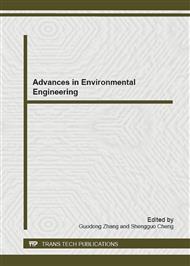[1]
B. Blocken, J. Carmeliet and T. Stathopoulos. CFD evaluation of wind speed conditions in passages between parallel buildings—effect of wall-function roughness modifications for the atmospheric boundary layer flow. Journal of Wind Engineering and Industrial Aerodynamics, Vol. 95 (2007), p.941–962.
DOI: 10.1016/j.jweia.2007.01.013
Google Scholar
[2]
Q. Wang, Q.M. Zhan. Numerical Simulation Analysis of Wind Environment in Residential Quarter in Wuhan.Chinese and Overseas Architecture, Vol. 12 (2010),pp.95-97.
Google Scholar
[3]
L. Yang. Study on Wind Environment around Wen Yuan Building in Tongji University.Huazhong Architectural, Vol. 05 (2010), pp.29-30.
Google Scholar
[4]
Y. Ding, B.Z. Li, Y. Shen, Y.Y. Su. Simulation for the Effect of Building Plan and Orientation on Natural Ventilation. Journal of Civil,ArchitecturaI&Environmental Engineering, Vol. 32, No.1 (2010), pp.90-96.
Google Scholar
[5]
B. Blocken, J.Persoon. Pedestrian wind comfort around a large football stadium in an urban environment: CFD simulation, validation and application of the new Dutch wind nuisance standard. Journal of Wind Engineering and Industrial Aerodynamics, Vol. 97 (2009) ,p.255–270.
DOI: 10.1016/j.jweia.2009.06.007
Google Scholar
[6]
Ministry of Housing and Urban-Rural Development of China.Evaluation standard for green building GB/T 50378—2006. China Architecture and Building Press, Beijing,2006.
Google Scholar
[7]
Ministry of Housing and Urban–Rural Development of China. The detail technical guide for green building assessment.http://www.mohurd.gov.cn
Google Scholar
[8]
S.L. Walker. Building mounted wind turbines and their suitability for the urban scale—Areview of methods of estimating urban wind resource. Energy and Building, Vol.43 (2011), pp.1852-1862.
DOI: 10.1016/j.enbuild.2011.03.032
Google Scholar
[9]
A. Zhang, C. Gao and L. Zhang. Numerical simulation of the wind field around different building arrangements. Journal of Wind Engineering and Industrial Aerodynamics, Vol. 93 (2005) , p.891–904.
DOI: 10.1016/j.jweia.2005.09.001
Google Scholar
[10]
L. Caracoglia, N.P. Jones. Analysis of full-scale wind and pressure measurements on a low-rise building. Journal of Wind Engineering and Industrial Aerodynamics, Vol. 97 (2009) , p.157–173.
DOI: 10.1016/j.jweia.2009.06.001
Google Scholar
[11]
K.Stathopoulos. Pedestrian level winds and outdoor human comfort. Journal of Wind Engineering and Industrial Aerodynamics, Vol. 94 (2006), p.769–780.
DOI: 10.1016/j.jweia.2006.06.011
Google Scholar
[12]
K.Y. He, L.L. Gan and H.Z. Zhou. Standardization Process of Wind Environmental Simulation in Green Building [J]. Building energy efficiency, Vol.39, No.8 (2011), pp.22-24.
Google Scholar
[13]
G. Evola , V. Popov. Computational analysis of wind driven natural ventilation in buildings. Energy and Buildings,Vol. 38 (2006) , p.491–501.
DOI: 10.1016/j.enbuild.2005.08.008
Google Scholar
[14]
Cun shang zhou san.Computational environment design for indoor and outdoor climates. China Architecture and Building Press, Beijing,2007,04. ISBN: 978-7-112-08981-9.
Google Scholar


